Plant Profiles
Click on the first letter of the common name of the plant you wish more information about.
A | B | C | D | E | F | G | H | I | J | K | L | M | N | O | P | Q | R | S | T | U | V | W | X | Y | Z
S
- Scarlet Sage
- Scarlet Swamp Mallow
- Shasta Daisy
- Shell Ginger
- Shooting Stars
- Showy Primrose
- Shumard Oak
- Silk-floss Tree
- Silk Flower
- Simpson Stopper
- Slash Pine
- Southern Live Oak
- Southern Magnolia
- Spider Flower
- Spider Plant
- Star Daisy
- Stock
- Stokes Aster
- Summer Poinsettia
- Summer Torch
- Swamp Mallow
- Sweet Gum
- Sweet Osmanthus
- Sweet Peas
- Sycamore
Scarlet Sage
Scientific Name: Salvia coccinea
Growth Habit: A bushy long-lived annual with numerous shoots growing to 2 feet tall and wide. The leaves are bright green, ovate with toothed margins growing to 2 inches long and about half as wide.
Light: Plant in full-sun to lightly shaded locations.
Feedings: Apply a light scattering of a general garden fertilizer under the spread of the plants every six to eight weeks March through November.
Water Needs: Drought tolerant, but grows best with weekly waterings.
Ease of Culture: Easy.
Propagation: Start plants from seeds or cuttings.
Hardiness: Hardy; may be damaged by cold but grows back from buds near the ground or seeds.
Major Problems: Caterpillars and grasshoppers may chew holes in the foliage and can be handpicked from the plants as needed. Slugs also may damage the foliage during damp weather and may need a control; set out a shallow tray of beer as a trap or use a bait available from garden centers.
Pruning: After months of growth, the plants spread out to fill garden sites and may interfere with nearby flowers and shrubs. Trim unwanted shoots to keep the plants in bounds. Also remove cold-damaged stems, and reshape plantings at the end of February. Older plantings become woody and often need replacement after a year of growth.
Uses: An excellent, almost carefree long-lived annual for flower gardens, natural settings and containers. Scarlet sage is a favorite of butterflies and hummingbirds, opening bright red tubular two-lipped flowers along terminal shoots held well above the foliage. Flowering is year-round but can be affected by cold weather. Pictured is the variety Lady In Red available as seeds and transplants along with other white and pink selections. Plantings reseed freely and may become a bit weedy in formal flower beds.
Florida Native: Yes.
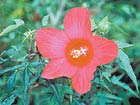
Scarlet Swamp Mallow
Scientific Name: Hibiscus coccineus
Growth Habit: An open-growing, deciduous, woody perennial growing to 8 feet tall and half as wide. The leaves are deeply cut into three or five segments and grow to 6 inches long and 4 inches wide. The foliage is bright green during the summer and turns reddish for fall.
Light: Grow in the full sun.
Feedings: Fertilize lightly with a general garden product once monthly in March and June.
Water Needs: Needs a moist soil; plant near lakes or boggy areas or keep moist in well-drained garden settings.
Ease of Culture: Easy; keep moist.
Propagation: Start plants from seeds or cuttings.
Hardiness: Hardy.
Major Problems: Chewing insects including grasshoppers and caterpillars may feed on the foliage but seldom need control. May decline during the drier months if not provided with adequate water.
Pruning: Cut back during late winter to renew older stems and reshape before spring growth begins. Additional pruning may be needed during the growing season to keep plants in bounds.
Uses: A colorful plant for aquatic gardens to display near water features and in boggy soils along lakes. Also may be planted in moist gardens to help create the natural Florida look and to add color June through October with the large 6-inch-diameter red blooms that attract butterflies and hummingbirds.
Florida Native: Yes.
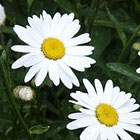
Shasta Daisy
Scientific Name: Chrysanthemum superbum
Growth Habit: A clump-forming evergreen perennial with clusters of deeply toothed dark green leaves. Plant grows to 1 foot tall; flower stalks, to 3 feet tall during late spring.
Light: Plant in full sun.
Feedings: Feed every other month with a light scattering of a general garden fertilizer March through November.
Water Needs: Prefers a moist site. Water transplants as needed to prevent wilting until the roots grow into the surrounding soil; water established plants weekly.
Ease of Culture: Easy.
Propagation: With seeds or by division of older plantings.
Hardiness: Hardy.
Major Problems: It can be difficult to find shasta daisies adapted to the Florida climate. Plants can be grown from seed but they seldom survive or flower. The best plants are grown locally and sold at garden centers or shared between friends. Opening blooms are often damaged by thrips and may need an insecticidal treatment.
Pruning: Remove old flower stalks as the blossoms decline. Plants are trimmed of old foliage and stem portions when divided after flowering in summer.
Uses: A carefree perennial for sunny flower gardens. Can be used as an evergreen backdrop for lower-growing annuals and perennials summer through winter. White daises with a yellow center open during April and May.
Florida Native: No.
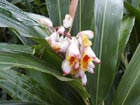
Shell Ginger
Scientific Name: Alpinia zerumbet
Growth Habit: An upright to rounded evergreen perennial growing to 8 feet tall and wide. The leaves are dark green and lancelike and grow to 2 feet long and 6 inches wide.
Light: Plant in full sun to light shade.
Feedings: Apply a light feeding of a general garden fertilizer once monthly in March and June.
Water Needs: Tolerates short periods of drought; grows best with weekly waterings.
Ease of Culture: Easy.
Propagation: Start plants by dividing older clumps.
Hardiness: Hardy; may be damaged by severe freezes but usually grows back from below-ground rhizomes.
Major Problems: May be damaged by chewing insects, but controls seldom are needed.
Pruning: Remove cold-damaged and older declining stems in late winter before growth begins. Plantings can grow rapidly and may need warm-season trimming to prevent shoots from affecting nearby shrubs and flowers.
Uses: A clump-forming ginger with dense growth that can be planted as a view barrier or a backdrop for other flowers and low-growing shrubs. The foliage adds the tropical look to the landscape. A variegated form is available to grow as an accent or a space divider. Flowers open in hanging clusters May through November with individual yellow-and-white blossoms resembling seashells.
Florida Native: No; native to Asia.
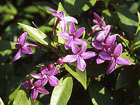
Shooting Stars
Scientific Name: Pseuderanthemum laxiflorum
Growth Habit:
Growth Habit: A multistemmed evergreen shrub growing to 4 feet tall and wide. The leaves are lancelike, bright green and grow to 4 inches long and 1 inch wide.
Light: Plant in full sun to light shade.
Feedings: Apply a general garden fertilizer once monthly in March, June and September, if needed to encourage growth.
Water Needs: Tolerates short periods of dry weather but grows best with weekly waterings.
Ease of Culture: Easy.
Propagation: Start plants from cuttings.
Hardiness: Tender; damaged by freezing temperatures but usually grows back from buds protected by mulches near the ground.
Major Problems: Plant in well-drained soil to prevent root-rot problems. Leaves occasionally are damaged by chewing insects but seldom need control.
Pruning: Plants grow vigorously and need periodic pruning during the growing season to remain in bounds. Remove cold damage in late February and reshape as needed.
Uses: A relatively new dense and lower-growing shrub to use in foundation and space-divider plantings that need minimal care. Clusters of purple blooms are held just above the foliage for color May through November. Plants also can be added to container gardens to display at entrances or on the patio and balcony.
Florida Native: No; native to the Fiji Islands.
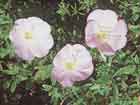
Showy Primrose
Scientific Name: Oenothera speciosa
Growth Habit: A creeping perennial with numerous shoots growing from underground rhizomes to form 1-foot-tall and often 3-foot-wide plants. The leaves are linear with a toothed margin, growing to 2 inches long and a half-inch wide.
Light: Plant in full sun to lightly shaded locations.
Feedings: Most plantings seldom needed fertilizer. Growth can be encouraged with a light feeding once monthly in March and June with a general garden fertilizer.
Water Needs: Drought tolerant. Water until established; thereafter the plant survives with seasonal rainfall.
Ease of Culture: Easy.
Propagation: Start plants from seed or cuttings and by dividing older clumps.
Hardiness: Hardy.
Major Problems: Tolerant of most pest problems. May occasionally be damaged by chewing insects and leaf spots, but controls are seldom needed.
Pruning: Can spread into nearby plantings and may need trimming to remain in bounds. Prune older stems immediately after blooms decline to encourage additional flowers. Also remove old stems and foliage before growth begins during late fall and winter.
Uses: An attractive flower for natural settings often planted along the roadside and in wildflower collections. May also be added to perennial gardens, used as a ground cover and planted in containers for patio and balcony displays. Individual white to pink blossoms about 2 inches in diameter open April through July.
Florida Native: No; native to Kansas and Texas.
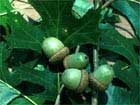
Shumard Oak
Scientific Name: Quercus shumardii
Growth Habit: A deciduous pyramidal-shaped tree growing to 50 feet tall and equally as wide. The leaves are large, glossy green with pointed tips and deeply cut lobs turning red to orange during fall.
Light: Plant in full-sun locations.
Feedings: Apply a general garden fertilizer in March and June for the first three years after planting. Thereafter trees normally obtain adequate nutrients from nearby shrub and lawn feedings.
Water Needs: A drought-tolerant tree that needs frequent watering only during the first year after planting. Established trees obtain adequate moisture from seasonal rains.
Ease of Culture: Easy.
Propagation: Start new trees from seeds or cuttings.
Hardiness: Hardy.
Major Problems: Oaks are relatively pest free. Occasionally caterpillars and mites may affect the foliage, but controls normally are not needed. Trees in soil that is too wet may develop root-rot problems.
Pruning: Start care immediately after planting by maintaining a central leader. Prune out limbs that compete with the central-most shoot at the top of the tree. Also trim as needed to maintain limbs evenly spaced around and up the trunk of the tree.
Uses: Gardeners wanting the Northern oak look should enjoy the Shumard species with large, glossy leaves that provide good fall color. Plant as a street or shade tree for the landscape. This is a large tree, so keep it at least 15 feet from the home and septic systems.
Florida Native: Yes.
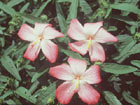
Silk Flower
Scientific Name: Abelmoschus moschatus
Growth Habit: A short-lived evergreen perennial growing to 3 feet tall and wide. The leaves are dark green and deeply cut, growing to 6 inches long and wide.
Light: Plant in full-sun locations.
Feedings: Apply a general garden fertilizer monthly.
Water Needs: Prefers a moist soil; water at 3- to 5-day intervals during hot, dry weather.
Ease of Culture: Easy.
Propagation: Start plants from seed.
Hardiness: Tender.
Major Problems: Slugs may feed on the foliage, especially during the wetter months. Control with beer traps or baits as needed. Whiteflies also may cause the foliage to yellow and decline. Control with soap sprays when the insects first are noted.
Pruning: Remove spent blooms or seedpods to encourage additional blooms. Trim back shoots growing out of bounds or affecting nearby plantings.
Uses: Most gardeners add silk flowers to annual beds, and remove them as the plants begin to fill with seedpods or decline during the winter months. As the blossoms suggest, this is an edible okra and hibiscus relative often called a musk mallow; it flowers May through November. The five-petal pink, red or white blossoms open to 4 inches in diameter with a white or yellow center. Plants also can be added to container gardens.
Florida Native: No; native to Asia.
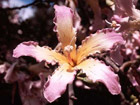
Silk-Floss Tree
Scientific Name: Chorisia speciosa
Growth Habit: A deciduous tree often with a large thorn-covered trunk that develops a rounded, open-growth habit growing to 50 feet tall and wide. The leaves are compound consisting of five to seven leaflets, each growing to 6 inches long and 2 inches wide. The leaves begin to drop during October as the flower buds open.
Light: Grow in full sun.
Feedings: Apply a general garden fertilizer once monthly in March and June for the first three years after planting. Thereafter, the trees usually obtain needed nutrients from nearby turf and shrub feedings.
Water Needs: Drought tolerant; water until the root system becomes established in the surrounding soil. Thereafter, seasonal rainfalls usually provide adequate moisture.
Ease of Culture: Easy.
Propagation: Trees are started from seed and by grafts formed from selected varieties.
Hardiness: Medium; protect when young from freezing weather. Well-established trees are more cold-tolerant but can be damaged by severe freezes.
Major Problems: Grow in a well-drained soil to avoid root rot problems. Roots often grow near the surface of the soil, making mowing and walking under the trees more difficult.
Pruning: Train young trees to a central leader until 8 to 10 feet tall; then allow new limbs to develop a rounded branching system. Remove limbs as needed to allow movement under the trees.
Uses: Plant as an accent in yards with room for a large tree. Best sites are to the rear or sides of the landscape where the tree can be used as a focal point to enjoy when in flower. The blossoms, up to 5 inches in diameter, open in October and November to attract much interest; they are pink with a white-and-yellow throat. Fruits occasionally form and contain white fibers that have been used to fill pillows.
Florida Native: No; native to Brazil and Argentina.
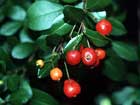
Simpson Stopper
Scientific Name: Myrcianthes fragrans
Growth Habit: An upright to rounded evergreen shrub or small tree growing to 20 feet tall and 10 feet wide. The leaves are shiny and lancelike growing to 1 inch and half as wide.
Light: Plant in full sun to light shade.
Feedings: Fertilize lightly once monthly in March, June and September with a general garden fertilizer for the first three years after planting. Once established, the plantings obtain needed nutrients from decomposing mulches and nearby feedings of shrubs and lawns.
Water Needs: Drought tolerant. Water when young to establish the root system in the surrounding soil; thereafter, the plantings usually survive with seasonal rains.
Ease of Culture: Easy.
Propagation: Start plants from seeds.
Hardiness: Hardy; young limbs may be damaged during severe freezes.
Major Problems: Chewing insects may damage foliage, but control is seldom needed.
Pruning: Train to a tree shape with multiple trunks by removing unwanted limbs as needed. Encourage branching of shrubs by periodically removing the tips of branches to develop a compact growth habit.
Uses: Plant as an accent tree for the patio, garden or along walkways. May also be used as a backdrop for gardens and as a space divider between landscape settings. Plants produce a major bloom of small, fragrant, cream-colored flowers in March and April but open sporadic blossoms throughout the year. Flowers are followed by orange-red berries that are a favorite food for wildlife. The plants also have an attractive peeling bark.
Florida Native: Yes.
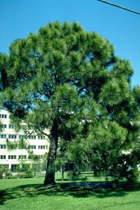
Slash Pine
Scientific Name: Pinus elliottii
Growth Habit: An upright needle-leaf evergreen tree with an open branching habit; grows to 75 feet tall. Needles are produced in clusters of two or three, and they grow to 12 inches long.
Light: Plant in full-sun locations.
Feedings: Apply a light application of a garden fertilizer in March and June for the first three years. Thereafter, the trees obtain nutrients from decomposing mulches and feedings of nearby shrubs and turf.
Water Needs: Keep moist until roots begin to grow into the soil. When established, the trees are drought-tolerant, usually surviving with moisture from seasonal rains.
Ease of Culture: Easy.
Propagation: Started from seed.
Hardiness: Hardy.
Major Problems: Prefers an acid soil. Grows best with a natural mulch over the root system. Excessive water or frequent feedings often cause decline. The trees are susceptible to damage during construction. Weakened trees may be affected by borers and stem diseases.
Pruning: Remove lower limbs as needed to allow movement and landscape maintenance under the trees. Also remove declining limbs to prevent borers and diseases.
Uses: Pines make excellent shade trees. They can be used as companion plants for azaleas, camellias and split-leaf philodendrons; each prefers the acid soils. Best planted in clusters where the area under the limbs can be left in a natural state and covered by the seasonal loss of pine needles.
Florida Native: Yes.
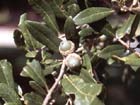
Southern Live Oak
Scientific Name: Quercus virginiana
Growth Habit: An evergreen wide-spreading tree growing to 60 feet tall and 100 feet wide. The leaves are dark green, oblong and slightly rolled at the edges and grow to 5 inches long and an inch wide.
Light: Plant in full-sun.
Feedings: Apply a 16-4-8 or similar fertilizer once monthly in March and June to newly planted trees for the first three years. Thereafter, decomposing mulches and feedings of nearby shrubs, lawns and flowers provide adequate nutrition.
Water Needs: Drought tolerant. Water new trees until the roots become established in the surrounding soil. Thereafter, the trees receive adequate moisture from seasonal rains.
Ease of Culture: Easy.
Propagation: Start trees from seeds or cuttings.
Hardiness: Hardy.
Major Problems: Live oaks are usually free of major pests but are affected by gall-forming insects that occasionally cause leaves and stems to develop unsightly swollen, knotted or fuzzy portions. Caterpillars might feed in the trees, causing some defoliation. Both problems seldom need control.
Pruning: Train new trees to a central leader to produce one main trunk. Remove or reduce the length of lower limbs after trees grow 8 to 12 feet tall as needed to perform yard work or allow movement under the trees.
Uses: A popular Florida tree to plant for shade in home landscapes. Add to areas where there is adequate room to accommodate the spreading growth habit that develops with age. The spring flowers are not showy but result in the production of fall acorns, a favorite food for wildlife. A number of new selections are available, including Cathedral, Highrise and Millennium oaks with uniform upright to rounded growth habits for home and street planting.
Florida Native: Yes.
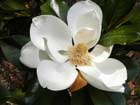
Southern Magnolia
Scientific Name: Magnolia grandiflora
Growth Habit: A pyramid-shaped evergreen tree growing to 80 feet tall and half as wide.
Light: Grows best in full sun but tolerates light shade.
Feedings: Apply a 16-4-8 or similar fertilizer once monthly in March and June to new tree plantings for the first three years. Thereafter, the nutrient needs normally are met by decomposing mulch or nearby feedings of lawns and ornamentals.
Water Needs: Prefers a moist soil; water every seven to 10 days during hot, dry weather until established. Once an extensive root system has developed in the surrounding soil, the trees are drought-tolerant.
Ease of Culture: Easy.
Propagation: Start plants from seed or cuttings or by grafting.
Hardiness: Hardy.
Major Problems: Scale can be a problem, covering the leaves with white dots and patches, but it seldom needs control. Gray algal and dark fungal leaf spots also may blemish leaves, but sprays normally are not needed.
Pruning: Train young trees to a single trunk with evenly spaced branches. Other trimming typically is limited to the removal of lower limbs that affect care and traffic under the trees.
Uses: An excellent shade tree opening a major display of large, fragrant, white blossoms April through June and sporadically during the summer. Seedpods form during the summer and often turn red, gradually revealing bright red seeds suspended by latexlike threads. A number of named varieties are available with predictable flowering and growth habits.
Florida Native: Yes.
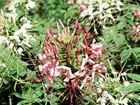
Spider Flower
Scientific Name: Cleome hasslerana
Growth Habit: An upright annual growing to 5 feet tall and 2 feet wide. Plants produce compound dark green leaves growing to 6 inches long with up to seven leaflets.
Light: Plant in a full-sun location.
Feedings: Apply a general garden fertilizer monthly during the growing season or scatter a slow-release fertilizer over the soil after planting to feed for several months.
Water Needs: Prefers a moist but well-drained soil; water at least weekly.
Ease of Culture: Easy.
Propagation: Start plants from seed.
Hardiness: Tender; can survive light frosts.
Major Problems: Chewing insects may feed on the foliage, but damage is usually minor; pests seldom need control. If soils are kept too moist, root-rot problems can develop.
Pruning: Plantings grow tall and may send out shoots that grow over walks and crowd nearby plantings. Stake plants to keep them upright and prune out-of-bounds limbs as needed.
Uses: A colorful annual flower for planting March to May and September to November in Central Florida. The flowers are formed from large clusters of white, pink and lavender blossoms with long stamens, producing a spiderlike look. Fill a large bed, use the plants as a backdrop for lower growing plantings or cluster several cleomes along walkways for spots of color.
Florida Native: No; native to Brazil and Argentina.
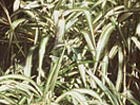
Spider Plant
Scientific Name: Chlorophytum comosum
Growth Habit: A clump-forming perennial growing to 1 foot tall and often twice as wide. The leaves are narrow, arise from near the ground and are solid green or variegated with yellow or white stripes.
Light: Plant in filtered-sun to shaded locations.
Feedings: Apply a general garden fertilizer once monthly in March, June and September.
Water Needs: Tolerates short periods of drought; grows best with weekly waterings.
Ease of Culture: Easy.
Propagation: Divide older clumps or allow plants forming at the ends of flowering shoots to root in pots or in the ground.
Hardiness: Medium; damaged by freezing weather but usually grows back from buds near the ground.
Major Problems: Check plants for mealybugs that multiply at the base of the foliage and along flowering shoots. Apply a soap or oil spray if needed. Scale insects and slugs also may need occasional control.
Pruning: In-ground plantings can grow out of bounds because of self-starting plants at the ends of flowering shoots. Prune as needed or allow them to root and move them to form new beds or container gardens.
Uses: An often overlooked colorful ground cover for shady spots. Plants grow quickly during the warmer months to form a tightly knit layer of foliage. The flowers are small, white and not showy. Plantings are grown mainly for the variegated foliage selections including variety 'Vittatum' with a white central stripe. Plants also form attractive hanging baskets and can be used in planters along with seasonal flowers.
Florida Native: No; native to South Africa.
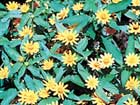
Star Daisy
Scientific Name: Melampodium paludosum
Growth Habit: A mound-forming, multibranched, long-lived annual growing to 18 inches tall and wide. The leaves are bright green and lancelike, growing to 3 inches long and 1 inch wide.
Light: Plant in full-sun locations.
Feedings: Apply a light scattering of a general garden fertilizer monthly.
Water Needs: Survives short periods of drought; grows best with weekly waterings.
Ease of Culture: Easy.
Propagation: Start plants from seed.
Hardiness: Tender; affected by frosts and freezes, but plants often grow back from seeds dispersed by older plants.
Major Problems: Caterpillars and other chewing insects often damage leaves but seldom need control. Plants reseed heavily, and the new growths can become a nuisance when trying to establish beds of different flowers.
Pruning: Seldom needed except to control plants that might be growing over walkways or into nearby flowers and shrubs. Cold-damaged plants also may need removal during late winter.
Uses: Unheard of until about 15 years ago, the star daisy -- also known as melampodium -- has become a garden favorite for its tolerance to drought, rains and hot weather. It's a durable annual usually planted spring through fall. Use in clusters of several plants to create a mound of 1-inch-diameter yellow blossoms that remain attractive for weeks before dropping their petals and then being replaced with flowering shoots. Plantings are in bloom year-round except when damaged by cold. Use in annual flower beds, perennial gardens and containers for the sunny locations. Numerous varieties are available; selection Show Star is pictured.
Florida Native: No; hybrids with parentage from North, Central and South America.

Stock
Scientific Name: Matthiola incana
Growth Habit: An upright cool-season annual growing to 18 inches tall. Plants produce long, narrow gray-green leaves and fragrant flowers in spikes held well above the foliage.
Light: Plant in full-sun to lightly shaded locations.
Feedings: Apply a general garden fertilizer monthly.
Water Needs: Maintain a moist soil. Water new plantings daily for the first week or two after planting; thereafter water when the surface soil begins to dry.
Ease of Culture: Easy.
Propagation: Start new plants from seed during fall through winter.
Hardiness: Hardy.
Major Problems: Must be planted during the cooler weather to prevent decline. Plant in nematode-free and well-drained soil to avoid root damage.
Pruning: Remove faded flowers to encourage more blooms.
Uses: Stock is a colorful winter annual with blue, lavender, pink, red, white and yellow blossoms. Flowers are fragrant and usually double. Plants are in bloom December though March. Add plantings to flower beds, or use them to fill container gardens. You may have to start your own stock from seed because few garden centers offer transplants.
Florida Native: No; native to Mediterranean region.
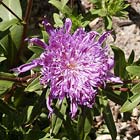
Stokes Aster
Scientific Name: Stokesia laevis
Growth Habit: An evergreen clump-forming perennial growing to 18 inches tall and wide. The leaves are straplike and medium green growing to 8 inches long and 1 inch wide.
Light: Tolerates full sun but grows best in light shade.
Feedings: Apply a light scattering of a general garden fertilizer every six to eight weeks March though October.
Water Needs: Drought tolerant for short periods of time; grows best with weekly waterings.
Ease of Culture: Easy.
Propagation: From seed or by dividing older clumps.
Hardiness: Hardy.
Major Problems: Plantings are usually pest free. Avoid overwatering and poorly drained soils that can cause root rot problems. Plant foliage is occasionally affected by leaf-chewing insects, but controls are seldom needed.
Pruning: Remove old flower heads as they form to encourage additional blooms. Also trimming off the older shoots encourages formation of larger clumps.
Uses: Plant in clusters in the perennial bed or along walkways to create a long flowering accent. The blossoms are blue, lavender or white and daisylike, opening to 4 inches in diameter. Plantings are in bloom April through June and provide nectar for butterflies. Flowering plants can be added to container gardens for use on patios and balconies.
Florida Native: Yes.
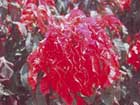
Summer Poinsettia
Scientific Name: Amaranthus tricolor
Growth Habit: An upright annual with attractive leaves growing to more than 4 feet tall and 18 inches wide. The leaves are lancelike and range in color from deep green to yellow, orange and red; they grow to more than 8 inches long and 4 inches wide.
Light: Plant in full-sun locations.
Feedings: Needs only light monthly feedings of a general garden fertilizer. Too much fertilizer may decrease foliage color.
Water Needs: Tolerates short periods of drought, but grows best with weekly waterings.
Ease of Culture: Easy.
Propagation: Start from seed.
Hardiness: Tender; plant only during the warmer months.
Major Problems: Chewing insects seem to like the large colorful leaves. Control caterpillars with Thuricide or a similar natural insecticide. Also plant in a well-drained soil.
Pruning: Plants seldom need pruning but do grow tall and often benefit from staking.
Uses: A real attention-getter for the flower garden. The leaves are the attractive portions; a red variety like Early Splendor (right) often resembles a poinsettia. The flowers are small and insignificant. Plant in clusters for a big burst of color against a backdrop of green shrubs or perennials. Plants also can be added to container gardens as the accent with other flowers or greenery. Additional selections with attractive foliage include Aurora, Flaming Fountain, Illumination and Molten Fire.
Florida Native: No; native to Africa.
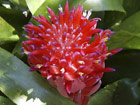
Summer Torch
Scientific Name: Billbergia pyramidalis
Growth Habit: An upright, evergreen, tropical perennial forming vaselike clusters of plants growing to 2 feet tall and wide. The leaves are medium green and straplike with a spiny edge and an abrupt tip growing to 18 inches long and 4 inches wide.
Light: Plant in shade to filtered-sun locations.
Feedings: Apply a light feeding once each month April through November if needed for growth. Mix a 20-20-20 or similar fertilizer at 1/4 the normal rate to water and feed the plants.
Water Needs: Drought tolerant; often can exist with moisture from seasonal rains. Plants grow best if the vaselike leaf arrangement is replenished with water during the dry times.
Ease of Culture: Easy.
Propagation: Start plants by dividing older clumps.
Hardiness: Tender; survives all but severe freezes when protected under trees. If damaged, most grow back from offshoots near the ground.
Major Problems: Scale insects can damage the foliage, causing brown spots on the leaves. Where needed, apply an oil spray following label instructions. Mosquitoes can live within the center moist sections of the plants and might need control during the warmer months.
Pruning: Older plantings can become invasive; divide to keep them in bounds. Also, remove cold-damaged leaves. Many gardeners like to remove the massive declining flower cluster to maintain attractive plants.
Uses: A plant for the shady areas of the landscape to use as a ground cover and an accent feature when in bloom. Cluster several plants to grow with other perennials and among shrub plantings. They also can be grown in containers to display on shady patios and balconies. Plantings produce a major flower display in August and September, developing foot-tall, bright-red inflorescences with small blue blossoms that remain attractive for about a week. Some selections also bloom in March or April. The flower clusters can be cut to use in bouquets.
Florida Native: No, native to Brazil.
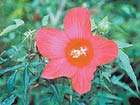
Swamp Mallow
Scientific Name: Hibiscus coccineus
Growth Habit: An upright deciduous perennial, with an open-branching habit, growing to 6 feet tall. The leaves grow to 4 inches long and wide, with 3 to 5 deeply cut lobes.
Light: Plant in full-sun to lightly shaded locations.
Feedings: Apply a general garden fertilizer once each month in March and June.
Water Needs: Needs damp garden sites for best growth; tolerates poorly drained soils. Maintain a moist soil with weekly waterings.
Ease of Culture: Easy; must have a moist site.
Propagation: Start plants with seeds or cuttings.
Hardiness: Hardy.
Major Problems: Leaves may be damaged by chewing insects, but controls are seldom needed.
Pruning: Plantings may grow a bit lanky and need periodic pruning to stay in bounds. Many gardeners remove the less attractive seedpods that form after flowering. The plants decline and go dormant for the winter months. Prune back to near the ground during late winter to make room for spring growth.
Uses: An attractive plant for the natural Florida settings and damp areas of the landscape. Best used as a backdrop with wetland gardens and water-garden features. Plantings grow rapidly in the spring, and in May through October, they open red blossoms up to 8 inches in diameter that attract hummingbirds.
Florida Native: Yes.
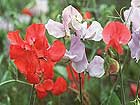
Sweet Peas
Scientific Name: Lathyrus odoratus
Growth Habit: Climbing annual vines with pairs of blue-green leaves clasping the stems and shoots growing to 6 feet tall. Entwining tendrils develop along the stems and attach to nearby fences and trellises.
Light: Grow in full sun.
Feedings: Add manure or compost to the planting site. After two to three weeks of growth, give one feeding of a complete garden fertilizer. Sweet peas are legumes that obtain additional nitrogen for growth from nitrogen-fixing bacteria in the soil.
Water Needs: Need a moist soil. Water when the surface inch of soil begins to dry. Add a 1- to 2-inch mulch.
Ease of Culture: Medium; sow seeds during cool weather.
Propagation: Start new plantings in a prepared garden site. Space the seeds 3 to 4 inches apart and cover with an inch of soil.
Hardiness: Hardy; tolerate frosts but damaged by severe freezes.
Major Problems: Need cool weather to grow and flower in the Florida climate. Plant October through February in a well-drained soil to avoid root and stem rot problems.
Pruning: Cut lots of bouquets and trim flowers as they begin to fade to encourage additional blooms.
Uses: Few flowers have the pleasing fragrance of sweet peas. Both bush and tall-growing varieties are available, but all need a trellis or fence for support. Grow in a garden row for cut flowers or plant as a backdrop for flower beds and patios. Early and winter- flowering types do best in Florida.
Florida Native: No; native to Italy.

Sweet Gum
Scientific Name: Liquidambar styraciflua
Growth Habit: An upright deciduous tree growing to 60 feet tall and 30 feet wide. The leaves are dark green and star-shaped, often confused with red maple leaves, growing to 5 inches long and wide.
Light: Grow in full-sun locations.
Feedings: Apply a general garden fertilizer once monthly in March and June for three years after planting. Thereafter, fertilizer applied to nearby lawns, shrubs and flower beds normally supplies the nutrient needs.
Water Needs: Drought tolerant; water daily after planting for a month or more and then every other day until established. Thereafter, seasonal rains normally provide adequate moisture.
Ease of Culture: Easy.
Propagation: Start plants from seed, through cuttings or by grafting.
Hardiness: Hardy.
Major Problems: Lace bugs and thrips often cause a bronzing of the foliage by the end of summer. This decline usually is ignored as the leaves are deciduous and lost during the fall months. Caterpillars may feed on the leaves in sections of the tree, but the damage is usually minor.
Pruning: The trees normally grow upright but may need guidance to keep a central leader. Maintain evenly spaced limbs round the trunk by removing conflicting branches. Remove lower limbs as needed in older trees to allow maintenance and passage under the trees.
Uses: This upright, medium-sized shade tree allows gardeners to keep their sunny areas while enjoying shade, too. Inconspicuous yellowish flowers are produced during the late winter. The female blooms develop spiny seed capsules that drop to the ground during fall and can be painful to bare feet. The star-shaped leaves are eye-catching and turn yellow, red or purple by late fall.
Florida Native: Yes.
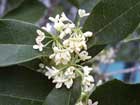
Sweet Osmanthus
Scientific Name: Osmanthus fragrans
Growth Habit: An upright evergreen shrub with numerous small branches growing in Central Florida as high as 10 feet tall and 5 feet wide; in cooler, more northern locations, 20 feet tall and almost as wide. The leaves resemble those of a holly,
Light: Plant in filtered sun or an area with morning sun and afternoon shade.
Feedings: Apply a general garden fertilizer once monthly in March and June.
Water Needs: Tolerates short periods of drought; grows best with weekly waterings.
Ease of Culture: Medium; needs a cool location in the landscape.
Propagation: Start shrubs from cuttings.
Hardiness: Hardy.
Major Problems: Generally problem-free, but limbs and leaves are sometimes affected by scale insects. Apply a natural oil spray if insects are noted.
Pruning: Keep plants compact and full of new growth by periodically removing the tips of shoots. Also trim declining limbs and out-of-bounds shoots as needed.
Uses: Gardeners usually notice the apricotlike fragrance of the flowers long before they spot the small cream-colored blooms clustered among the foliage. Position a plant or two near a patio and along the walkway to enjoy the period of major blooms February through March and then sporadically throughout the year. The sweet osmanthus, also called tea olive, is at its most southern limit, and finding the right spot in the landscape is important for it to thrive.
Florida Native: No; native to Eastern Asia.
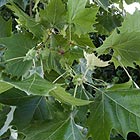
Sycamore
Scientific Name: Platanus occidentalis
Growth Habit: An upright pyramidal-shaped deciduous tree growing to 80 feet tall and 60 feet wide with strong, well-spaced horizontal branches and peeling tan to cream or white bark. The leaves are rounded, three-to-five-lobed and medium green, growing to 8 inches long and wide.
Light: Plant in a full-sun location.
Feedings: Fertilize with a lawn-care product once monthly in March and June for the first three years after planting. Thereafter, special feedings are seldom needed as the trees obtain needed nutrients from nearby lawn and shrub fertilizer applications.
Water Needs: Trees have medium drought tolerance, often developing brown edges on the leaves, called scorch, during the drier weather. They grow best with weekly waterings.
Ease of Culture: Easy.
Propagation: Start trees from seed.
Hardiness: Hardy.
Major Problems: Sycamores often develop brown leaves by midsummer because of lace bug infestations. Gardeners normally ignore the damage because the leaves drop a few months later during the fall. Powdery mildew also may be noticed as a white coating on the young leaves during spring, but it is usually a minor problem treatable with a fungicide, if needed. Some gardeners object to the large leaves that drop during the late fall.
Pruning: Sycamores grow a single, straight trunk with evenly spaced branches. Care is needed to make sure the trunk is not damaged and to maintain the single central leader. Lower limbs can be removed as needed to allow movement under the trees after the trunks grow to 8 feet or more in height.
Uses: A popular shade tree for home landscapes. Due to its size, the sycamore should be planted only in yards with adequate room for growth and 15 or more feet from buildings, sidewalks and driveways. The flowers are insignificant but are followed by green, ball-like seed clusters that are more than 1 inch in diameter, giving the tree some ornamental value. Gardeners also like the peeling bark that reveals a smooth cream- to white-colored trunk that becomes an accent feature for the fall and winter months.
Florida Native: Yes.

